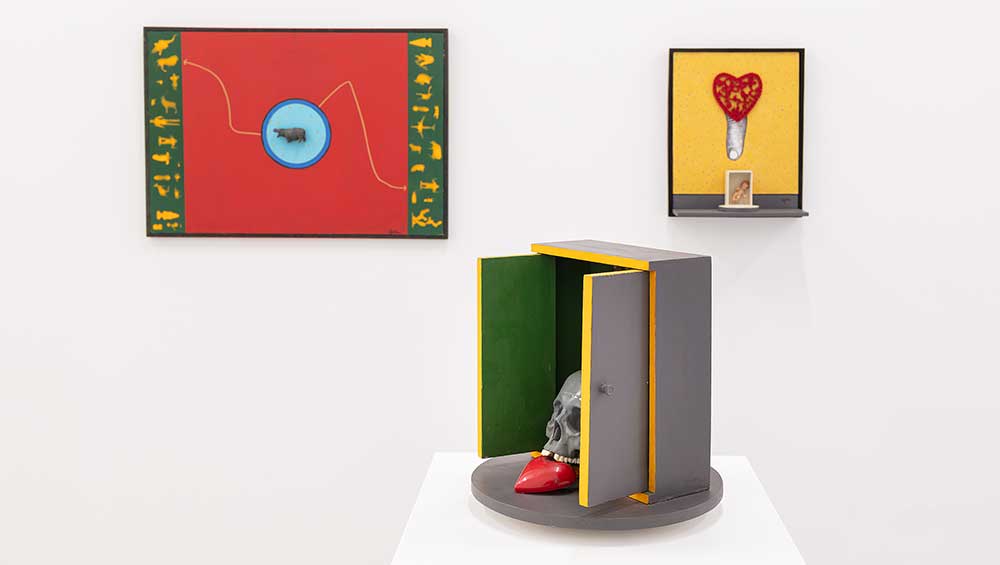
Ofelia Rodríguez, Talking in Dreams, 2023. Installation view, Spike Island, Bristol. Photo: Dan Weill.
Spike Island, Bristol
30 September 2023 – 14 January 2024
by TOM DENMAN
It is an astonishing case of cultural negligence that the artist being exhibited at Bristol’s Spike Island is hardly known outside her native Colombia. The world is a biased place, especially against Latin American female artists of colour emerging in the last century. This survey begins with some of Ofelia Rodríguez’s earliest known works, sketches in gouache and acrylic she made at the University of the Andes in Bogotá in the late 1960s, which would win her a Ford Foundation scholarship to Yale School of Art in 1970. At this time, abstract expressionism was still going strong in the US, and we can see why her work appealed to the board of admissions. Round-edged swathes of black, white, and often an earthy red or yellow, inkily intertwine, always honouring the flatness of the surface. But her welcome was accompanied by significant opposition, mainly from her tutors, who aimed to iron out her otherness, regarding her Colombian roots as a hinderance to her attaining Greenbergian modernist perfection. Through such conflict with US – and later, with European – hegemony, she tuned her self-awareness as a Colombian artist, more specifically from the city of Barranquilla on the Caribbean coast, and as being part of the larger political entity of Latin America.
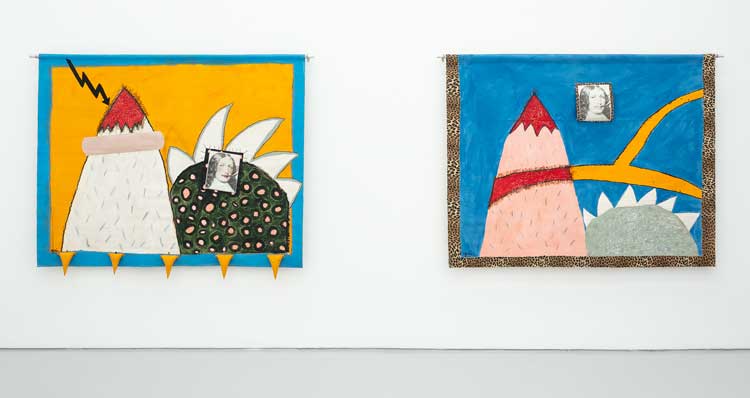
Ofelia Rodríguez, Talking in Dreams, 2023. Installation view, Spike Island, Bristol. Photo: Dan Weill.
With its history and demographic closely tied to the slave trade, Colombia’s northern coastline is culturally very different from the more Spanish-influenced interior around Bogotá. One manifestation of this difference is Barranquilla’s carnival, one of the largest in the world (in a 1994 interview with Jane Pavitt, Rodríguez explains that this part of the country has more in common with Brazil). A print of 1983, titled Carnival, is a direct reference: a masked form, blue like the ocean, crested like a monster, hugs and kisses, or maybe bites, a pink growth. The work feels less of a depiction of carnival itself – although it could be that, too – than a graphic configuration of the carnivalesque, an atmospheric note that runs through the show. The exuberance of colour, the alliances of high and low – seen, for instance, in the frequent appearance of plastic animals, referring to folkloric masks and dances, as well as to the kitschy aesthetic of carnival – and the sense of uprootedness in Rodríguez’s work speak to the subversive liminal condition conjured by the carnivalesque as a performative mode. This ties in with the history of blackness in Caribbean Columbia – carnival originating as a festival for slaves, which spawned practices of anticolonial mimicry and masquerade.
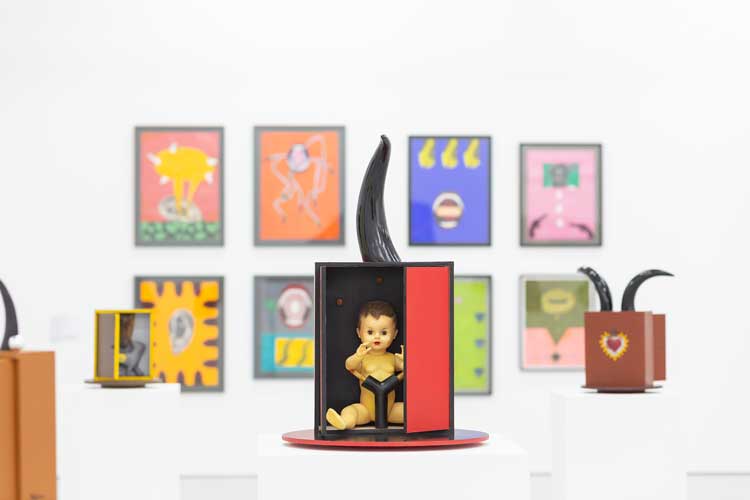
Ofelia Rodríguez, Talking in Dreams, 2023. Installation view, Spike Island, Bristol. Photo: Dan Weill.
The carnivalesque, characterised largely by a state of in-betweenness – in which everyday life and social norms are put on hold – also mirrors Rodríguez’s status as a diasporic subject, her dislocated identity in perpetual flux; both as somebody of part-African heritage born and raised in Colombia and as a Colombian in the US and subsequently in Paris, where she moved in 1978, and finally in London, where she lived from 1984. Her cartoonishly funny, semi-cartographic abstractions of ferocious terrains challenge the touristic fantasy of the tropics as paradise – as if pushing back at the stereotype were a means of gripping on to her own past, which she lays claim to by means of her own, highly subjective fantastical visions. Landforms are also deformed bodies in pain: breasts pustulate from hilly, hairy scrotums; a palm tree becomes a cauterised blood vessel; sharp edges loom or protrude from the canvas in the form of plastic beaks.
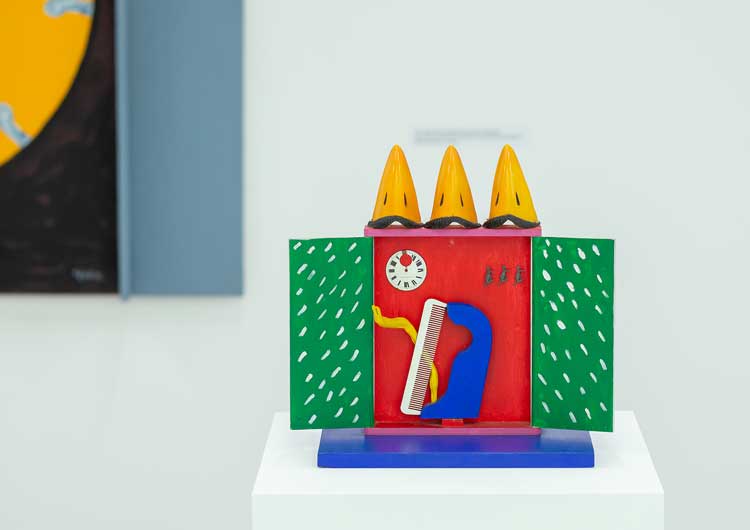
Ofelia Rodríguez, Magic Box with Beaks, 1988. Mixed media. Installation view, Talking in Dreams, Spike Island, Bristol. Photo: Dan Weill.
Collaged into some of her paintings of the late 80s are borders of floral or animal-print fabric theatrically lining the top edge and sides. Three Characters Floating in Midair (1988) and Dying Landscape in Midair (1989) feature actual broomsticks, which invite feminist readings, with the wallpaperish borders metonymising the home, while also curtaining hilarious puppet shows about genders clashing. In the former, the broom is taped to an erect promontory flanked at the hilt by spotty bananas; in the latter, the broom sweeps at a giant swirly striped sperm. A painting on the opposite wall features a photograph of Latin American art’s most famous – and most famously tempestuous – couple, Frida Kahlo and Diego Rivera, within a shrinelike box bleeding into the land. The religious reference gives them ancestral status, while also revealing Rodríguez’s conscious association with Latin America as a whole, even though she did not share Kahlo’s indigenism.
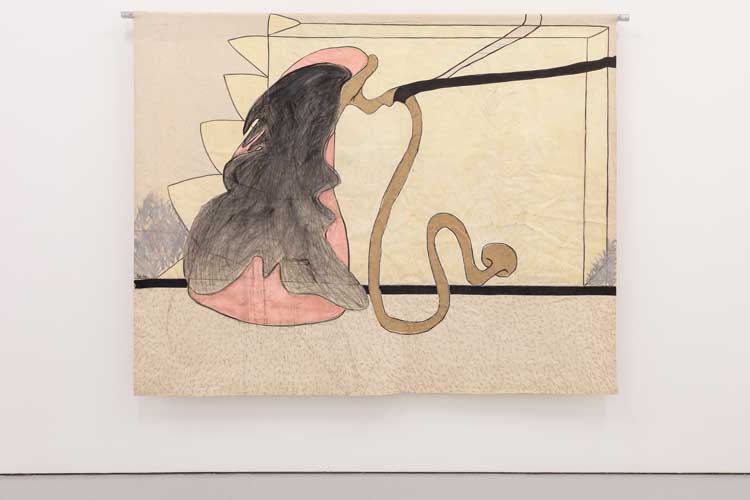
Ofelia Rodríguez, Organic Gramaphone with Silvery Lawn, 1979. Mixed media on canvas, pins and stitched. Installation view, Talking in Dreams, Spike Island, Bristol. Photo: Dan Weill.
Home is a thematic vector not only of domesticity, but more significantly of homeland, to which Rodríguez looked back from a position of self-determined exile. Humour alleviates real pain and real violence, revolving around her memories of Barranquilla. This is not to say that alleviation anaesthetises. Rather, it allows the work to exist in playful suspension between make-believe and reality, with the former always grounded in, and at the brink of becoming, the latter. Pain and violence are often felt in Rodríguez’s remembering, which works in conjunction with dismembering in the breakdown of bodies as topographies, as if to represent the painful and violent underpinnings of diasporic life – while the vibrance of colour and caprice celebrate the creativity, and thus the freedom, that might be born of this. Such contradiction is enacted in her frequent use of stitching to bind colour fields, some of which are dotted with metal pins, such as in Flowering in the Tropics (1992). She “always hated” sewing, she said, but did it anyway; this masochism might be detectable in the frustrated crudeness of her seams. As the theorist Elaine Scarry noted, sewing is a paradox of world-making and unmaking, repair and pain: the needle that stitches also pricks.
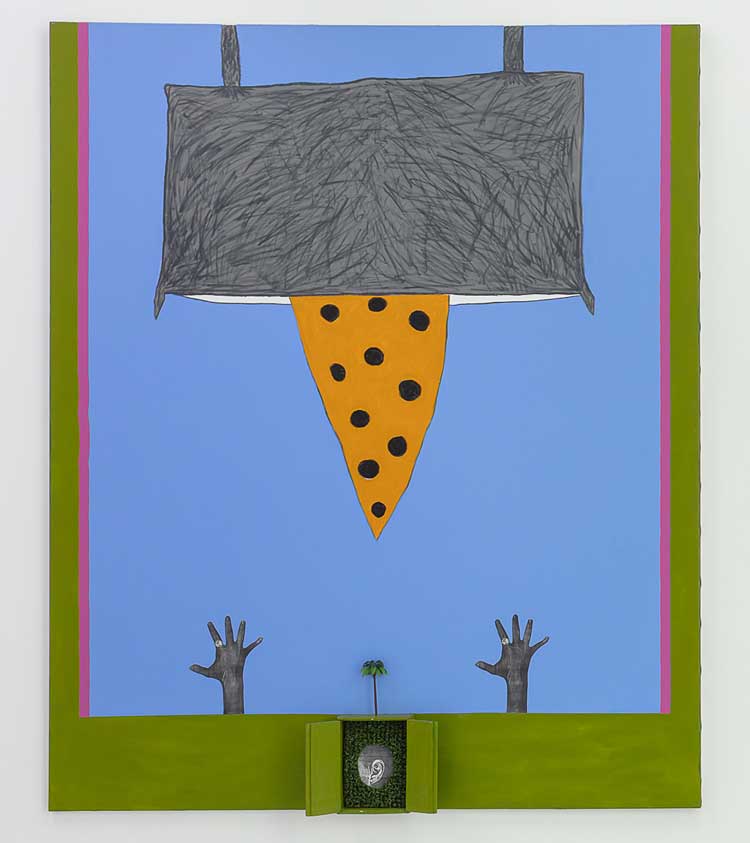
Ofelia Rodríguez, Lending an Ear to the Past, 1994. Mixed media on canvas. Installation view, Talking in Dreams, Spike Island, Bristol. Photo: Dan Weill.
In the mid-90s, Rodríguez’s unruly organic forms gave way to neater configurations of flatter, sometimes symmetrical planes of colour. And the simple arrangement of symbolic readymades on these tabular surfaces gives them a kind of emblematic legibility. Toy animals and dolls, bull horns, plastic teats and photocopies of the artist’s (right) hand, ears and eyes recur. In Lending an Ear to the Past (1994), her hands reach for the hybrid mechanical creature, while her ear listens from a box positioned beneath them. As collaged photocopies, her dismembered body is both representationally closer to herself and physically distanced from the canvas – from the “past”. We can feel her stepping back, as if to find a new vantage point, seeking a different kind of bodily engagement. This is often through avatars: in the sutured eye in The Eye in the Sky Looking Sadly at the Dead (1995), and most evidently in the myriad rubber teats. Uniting her naivety of style with her desire to connect with her own formation, these are comparable to her stiches, being at once evocative of pain and nurture. In some works, such as Floating Landscape with Horns (1993), the nipples even emit thread.
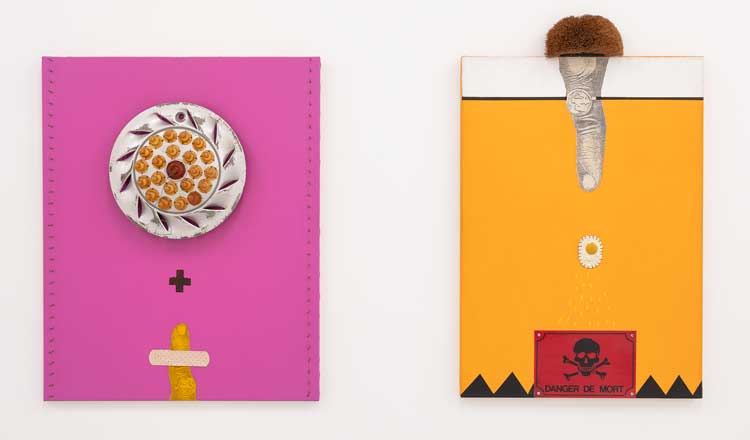
Left: Ofelia Rodríguez, Through the Mouth Yet Lacking Words, 1998. Mixed media on canvas. Right: Danger of Death, 1998. Mixed media on canvas. Installation view, Talking in Dreams, Spike Island, Bristol. Photo: Dan Weill.
In these later works, the psychological complexity is less in her embodied encounter with her materials than in the invisible numinosity emanating from the placement of fetishes. They are painterly equivalents to the magic boxes she began making in the 80s, as independent sculptures and as items she affixed to her canvases. While these most closely resemble portable shrines, they also embody the home, playfully and fantastically channelled through the dollshouse. Many contain carved or plastic figurines of animals or macabre dolls – such as the baby straddling a Y-shaped object (designed, it would seem, to prevent it from escaping) tipped with Halloween fingers. The art historian Dawn Adès observed that in her idiosyncratic way of relaying Colombian popular memory, Rodríguez aligned herself with the magical fiction of Latin American novelists such as Gabriel Gárcia Márquez without relying on dominant (US and European) forms of visual expression, “even if [her assemblages] do not have the discursive power of written language”. It could be further argued that it was through her refusal of such discursiveness, especially in her frank presentation of the readymade, that Rodríguez honoured the polyvalency and changeability of cultural signs. That she died but a month before the opening of this show lends it an inadvertent note of poignancy, counterbalanced by work so ardently alive.